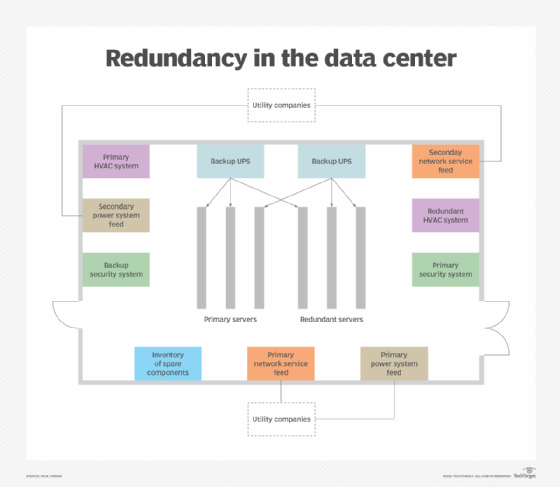What Happens to Redundancy If Company Goes Bust? A Guide to Your Rights
What Happens to Redundancy If Company Goes Bust? A Guide to Your Rights
Blog Article
Checking Out the Operational Dynamics of Business Redundancy and Its Long-Term Sustainability

Redundancy Methods for Organization Connection
In order to make sure continuous procedures, services need to carry out efficient redundancy techniques for service connection. Redundancy in this context refers to the replication of crucial elements or functions within a system to reduce the impact of potential failings. By integrating redundancy approaches, organizations can enhance their durability versus disturbances caused by numerous elements such as natural calamities, equipment failures, or cyber-attacks.
One usual redundancy technique is the implementation of back-up systems and information storage space options. This includes producing duplicates of vital data and systems that can be activated in instance of a main system failure. Furthermore, organizations can develop redundant interaction channels and power sources to maintain connection and operations throughout unpredicted events.
In addition, cross-training staff members to do numerous functions within the company can offer as a useful redundancy method. If crucial personnel are inaccessible due to health problem or various other reasons, this makes certain that crucial jobs can still be lugged out also. On the whole, reliable redundancy techniques are vital for services to copyright operational connection and lessen the influence of potential interruptions.
Impact of Redundancy on Business Resilience
Provided the vital role redundancy methods play in guaranteeing service connection, discovering the influence of redundancy on business resilience becomes vital for understanding the all natural operational characteristics of a company. Business strength describes an entity's ability to adapt to interruptions, recoup from setbacks, and change when required while maintaining core functions. Redundancy, when purposefully carried out, can significantly contribute to boosting an organization's durability in the face of unforeseen difficulties. By having back-up systems, workers, or processes in position, firms can much better endure shocks and continue procedures with marginal disruption.
In addition, redundancy can reinforce employee spirits and confidence, knowing that there are contingency strategies in place to address unpredicted conditions. This feeling of protection can bring about raised efficiency and a more favorable workplace. Furthermore, redundancy can promote development and creative thinking within a company as workers feel equipped to take computed risks, understanding that there is a safeguard to support them in case of failure. In general, the effect of redundancy on organizational resilience is extensive, shaping the lasting sustainability and success of a business.
Balancing Performance and Adaptability in Redundancy
Accomplishing an unified stability between functional efficiency and adaptive adaptability is a critical difficulty in the critical implementation of redundancy within companies. Effective operations are important for maintaining productivity and cost-effectiveness, ensuring that sources are used optimally. Nonetheless, extreme focus on performance alone can cause rigidness, making it hard for companies to adapt to unexpected modifications or challenges. On the other hand, versatility permits companies to react nimbly to advancing conditions, fostering advancement and resilience. Yet, also much versatility without a strong operational foundation can lead to inadequacies and incongruity.
To balance performance and adaptability in redundancy planning, organizations need to thoroughly evaluate their functional needs, market characteristics, and tactical goals. Inevitably, locating the appropriate stability between performance and adaptability is essential for developing a resilient and lasting organization in the face of unpredictability.
Long-Term Sustainability Through Redundancy Preparation
To ensure long-lasting practicality and security, companies need to tactically align their redundancy planning with long-lasting sustainability goals, consequently balancing functional effectiveness with flexible versatility. Long-term sustainability through redundancy preparation entails even more than just temporary cost-cutting actions. It needs a thorough tactical method that expects future difficulties and chances. Companies ought to check out redundancy not as a reactive option to immediate troubles but as an aggressive link strategy for long-term success. By integrating redundancy planning with sustainability objectives, organizations can develop a durable structure that can hold up against numerous market fluctuations and internal adjustments.

Proactive Actions for Lasting Firm Procedures
How can business proactively boost their functional sustainability for long-term success? Executing proactive steps is necessary for business intending to ensure sustainable operations. One vital approach is to purchase modern technology and advancement to enhance procedures, decrease waste, and stay competitive in the market. Adopting sustainable practices such as minimizing power intake, minimizing carbon impact, and enhancing source usage can not just profit the setting however additionally bring about cost financial savings over time.
In addition, cultivating a culture of continual renovation and understanding within the company can enhance versatility to changing market problems and client needs. Motivating worker participation in decision-making processes and supplying opportunities for professional development can improve morale, performance, and overall efficiency. Developing clear goals, checking crucial efficiency signs, and consistently assessing progression are essential parts of proactive sustainability management.
Collaborating with providers, consumers, and various other stakeholders to promote lasting methods throughout the supply chain can produce a ripple result of favorable influence - redundancy pay if company goes bust. By taking positive steps in the direction of operational sustainability, companies can construct durability, drive technology, and protect their lasting success in an ever-evolving service landscape
Conclusion

In the world of business management, the calculated implementation of business redundancy stands as an essential yet detailed practice that necessitates a fragile balance between operational performance and lasting practicality. By studying the functional characteristics that underpin business redundancy and assessing its more comprehensive ramifications for organizational durability and flexibility, a nuanced understanding of exactly how redundancy strategies can shape the future trajectory of a company starts to unravel.Given the critical duty redundancy approaches play in guaranteeing business continuity, exploring find this the impact of redundancy on business strength ends up being critical for recognizing the all natural operational dynamics of a firm. On the whole, the effect of redundancy on business durability is extensive, forming the long-term sustainability and success of a business.
In final thought, recognizing the functional characteristics of company redundancy is vital for making certain long-term sustainability.
Report this page